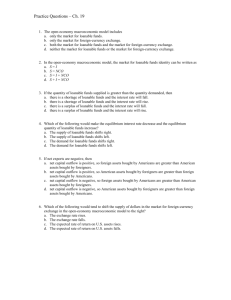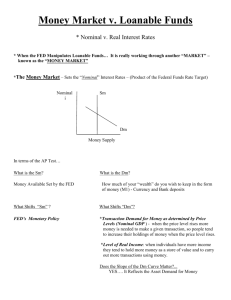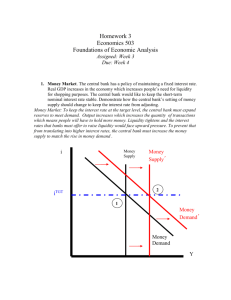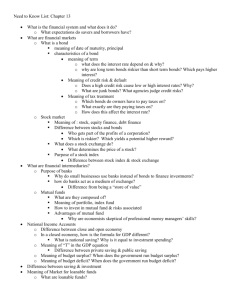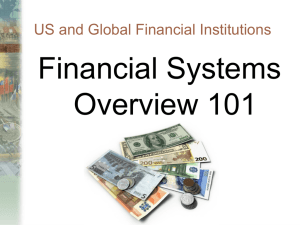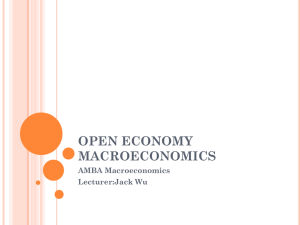Chapter 19 (31) - Practice Test
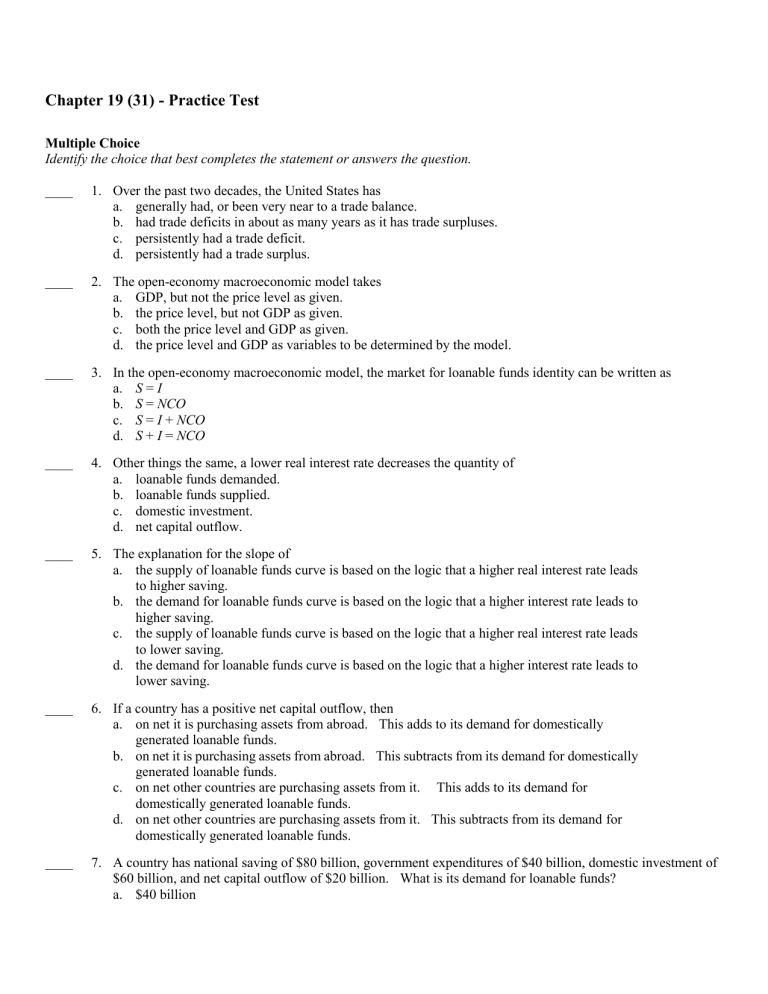
Chapter 19 (31) - Practice Test
Multiple Choice
Identify the choice that best completes the statement or answers the question.
____ 1. Over the past two decades, the United States has a. generally had, or been very near to a trade balance. b. had trade deficits in about as many years as it has trade surpluses. c. persistently had a trade deficit. d. persistently had a trade surplus.
____ 2. The open-economy macroeconomic model takes a. GDP, but not the price level as given. b. the price level, but not GDP as given. c. both the price level and GDP as given. d. the price level and GDP as variables to be determined by the model.
____ 3. In the open-economy macroeconomic model, the market for loanable funds identity can be written as a. S = I b. S = NCO c. S = I + NCO d. S + I = NCO
____ 4. Other things the same, a lower real interest rate decreases the quantity of a. loanable funds demanded. b. loanable funds supplied. c. domestic investment. d. net capital outflow.
____ 5. The explanation for the slope of a. the supply of loanable funds curve is based on the logic that a higher real interest rate leads to higher saving. b. the demand for loanable funds curve is based on the logic that a higher interest rate leads to higher saving. c. the supply of loanable funds curve is based on the logic that a higher real interest rate leads to lower saving. d. the demand for loanable funds curve is based on the logic that a higher interest rate leads to lower saving.
____ 6. If a country has a positive net capital outflow, then a. on net it is purchasing assets from abroad. This adds to its demand for domestically generated loanable funds. b. on net it is purchasing assets from abroad. This subtracts from its demand for domestically generated loanable funds. c. on net other countries are purchasing assets from it. This adds to its demand for domestically generated loanable funds. d. on net other countries are purchasing assets from it. This subtracts from its demand for domestically generated loanable funds.
____ 7. A country has national saving of $80 billion, government expenditures of $40 billion, domestic investment of
$60 billion, and net capital outflow of $20 billion. What is its demand for loanable funds? a. $40 billion
b. $60 billion c. $80 billion d. $120 billion
____ 8. An increase in the U.S. real interest rate induces a. Americans to buy more foreign assets, which increases U.S. net capital outflow. b. Americans to buy more foreign assets, which reduces U.S. net capital outflow. c. foreigners to buy more U.S. assets, which reduces U.S. net capital outflow. d. foreigners to buy more U.S. assets, which increases U.S. net capital outflow.
____ 9. If interest rates rose more in Germany than in the U.S., then other things the same a. U.S. citizens would buy more German bonds and German citizens would buy more U.S. bonds. b. U.S. citizens would buy more German bonds and German citizens would buy fewer U.S. bonds. c. U.S. citizens would buy fewer German bonds and German citizens would buy more U.S. bonds. d. U.S. citizens would buy fewer German bonds and German citizens would buy fewer U.S. bonds.
____ 10. If there is a shortage of loanable funds, then a. the demand for loanable funds will shift right so the real interest rate rises. b. the supply of loanable funds will shift left so the real interest rate falls. c. there will be no shifts of the curves, but the real interest rate rises. d. there will be no shifts of the curves, but the real interest rate falls.
____ 11. If the demand for loanable funds shifts left, then a. the real interest rate and the equilibrium quantity of loanable funds both fall. b. the real interest rate falls and the equilibrium quantity of loanable funds rises. c. the real interest rate and the equilibrium quantity of loanable funds both rise. d. the real interest rate rises and the equilibrium quantity of loanable funds falls.
____ 12. If the supply of loanable funds shifts right, then a. the real interest rate and the equilibrium quantity of loanable funds both fall. b. the real interest rate falls and the equilibrium quantity of loanable funds rises. c. the real interest rate and the equilibrium quantity of loanable funds both rise. d. the real interest rate rises and the equilibrium quantity of loanable funds falls.
____ 13. Which of the following would make the equilibrium real interest rate increase and the equilibrium quantity of funds decrease? a. The demand for loanable funds shifts right. b. The demand for loanable funds shifts left. c. The supply of loanable funds shifts right. d. The supply of loanable funds shifts left.
Figure 32-1
8
7
6
5
4
3
2
1
percent
10 20 30 40 50 60 70
$billions
____ 14. Refer to Figure 32-1 . In the Figure shown, if the real interest rate is 6 percent, the quantity of loanable funds demanded is a. $20 billion, and the quantity supplied is $40 billion. b. $20 billion, and the quantity supplied is $60 billion. c. $60 billion, and the quantity supplied is $20 billion. d. $60 billion, and the quantity supplied is $40 billion.
____ 15. Refer to Figure 32-1 . In the Figure shown, if the real interest rate is 2 percent, there will be a a. surplus of $20 billion. b. surplus of $40 billion. c. shortage of $20 billion. d. shortage of $40 billion.
____ 16. If net exports are positive, then a. net capital outflow is positive, so foreign assets bought by Americans are greater than
American assets bought by foreigners. b. net capital outflow is positive, so American assets bought by foreigners are greater than foreign assets bought by Americans. c. net capital outflow is negative, so foreign assets bought by Americans are greater than
American assets bought by foreigners. d. net capital outflow is negative, so American assets bought by foreigners are greater than foreign assets bought by Americans.
____ 17. Which of the following is included in the supply of U.S. dollars in the market for foreign-currency exchange in the open-economy macroeconomic model? a. A retail outlet in Canada wants to buy handbags from a U.S. manufacturer. b. A U.S. bank loans dollars to Karen, a U.S. resident, who wants to purchase a car in the U.S. c. A U.S. based law firm wants to build a new office in Japan. d. All of the above are correct.
____ 18. Which of the following would tend to shift the supply of dollars in the market for foreign-currency exchange in the open-economy macroeconomic model to the right? a. The exchange rate rises. b. The exchange rate falls. c. The expected rate of return on U.S. assets rises. d. The expected rate of return on U.S. assets falls.
____ 19. When the real exchange rate for the dollar appreciates, U.S. goods become a. less expensive relative to foreign goods, which makes exports rise and imports fall. b. less expensive relative to foreign goods, which makes exports fall and imports rise.
c. more expensive relative to foreign goods, which makes exports rise and imports fall. d. more expensive relative to foreign goods, which makes exports fall and imports rise.
____ 20. The theory of purchasing-power parity implies that the demand curve for foreign-currency exchange is a. downward sloping. b. upward sloping. c. horizontal. d. vertical.
____ 21. In the open-economy macroeconomic model, if for some reason foreign citizens want to purchase more U.S. goods and services at each exchange rate, then a. the demand for dollars in the market for foreign-currency exchange shifts right. b. the demand for dollars in the market for foreign-currency exchange shifts left. c. the supply of dollars in the market for foreign-currency exchange shifts right. d. the supply of dollars in the market for foreign-currency exchange shifts left.
____ 22. In the open-economy macroeconomic model, equilibrium in the market for foreign-currency exchange is determined by the equality between the supply of dollars which comes from a. U.S. national saving and the demand for dollars for U.S. net exports. b. U.S. net capital outflow and the demand for dollars for U.S. net exports. c. domestic investment and the demand for U.S. net exports. d. foreign demand for U.S. goods and services and U.S. demand for foreign goods and services.
____ 23. In the open-economy macroeconomic model, if there is a surplus in the market for foreign-currency exchange, which of the following will move the market to equilibrium? a. the real exchange rate depreciates and net exports fall. b. the real exchange rate depreciates and net exports rise. c. the real exchange rate appreciates and net exports fall. d. the real exchange rate appreciates and net exports rise.
____ 24. In the open-economy macroeconomic model, the key determinant of net capital outflow is the a. nominal exchange rate. b. nominal interest rate. c. real exchange rate. d. real interest rate.
____ 25. U.S. net capital outflow a. is a source of the supply of loanable funds, and the source of the supply of dollars in the foreign exchange market. b. is a source of the supply of loanable funds, and a source of the demand for dollars in the foreign exchange market. c. is a part of the demand for loanable funds, and the source of the supply of dollars in the foreign exchange market. d. is a part of the demand for loanable funds, and a source of the demand for dollars in the foreign exchange market.
____ 26. In the open-economy macroeconomic model, if the U.S. interest rate rises, then its a. net capital outflow rises, so the supply of dollars in the market for foreign exchange shifts right. b. net capital outflow rises, so the demand for dollars in the market for foreign exchange shifts right. c. net capital outflow falls, so the supply of dollars in the market for foreign exchange shifts
left. d. net capital outflow falls, so the demand for dollars in the market for foreign exchange shifts left.
____ 27. If U.S. residents want to buy more foreign bonds, then in the market for foreign-currency exchange the exchange rate a. and the quantity of dollars traded rises. b. rises and the quantity of dollars traded falls. c. falls and the quantity of dollars traded rises. d. and the quantity of dollars traded falls.
____ 28. In the open-economy macroeconomic model, if investment demand increases, then a. the supply of dollars in the market for foreign-currency exchange shifts left. b. the supply of dollars in the market for foreign-currency exchange shifts right. c. the demand for dollars in the market for foreign-currency exchange shifts left. d. the demand for dollars in the market for foreign-currency exchange shifts right.
____ 29. Because a government budget deficit represents a. negative public saving, it increases national saving. b. negative public saving, it decreases national saving. c. positive public saving, it increases national saving. d. positive public saving, it decreases national saving.
____ 30. When a government increases its budget deficit, then that country’s a. supply of loanable funds shifts right. b. supply of loanable funds shifts left. c. demand for loanable funds shifts right. d. demand for loanable funds shifts left.
____ 31. If the U.S. government increased its deficit, then a. U.S. bonds would pay higher interest but a dollar would purchase fewer foreign goods. b. U.S. bonds would pay higher interest and a dollar would purchase more foreign goods. c. U.S. bonds would pay lower interest and a dollar would purchase fewer foreign goods. d. U.S. bonds would pay lower interest but a dollar would purchase more foreign goods.
____ 32. Which of the following would not be a consequence of an increase in the U.S. government budget deficit? a. U.S. interest rates rise. b. U.S. net capital outflow falls. c. The real exchange rate of the U.S. dollar depreciates. d. The U.S. supply of loanable funds shifts left.
____ 33. Which of the following contains a list only of things that increase when the budget deficit of the U.S. increases? a. U.S. supply of loanable funds, U.S. interest rates, U.S. domestic investment b. U.S. imports, U.S. interest rates, the real exchange rate of the dollar c. U.S. interest rates, the real exchange rate of the dollar, U.S. domestic investment d. the real exchange rate of the dollar, U.S. net capital outflow, U.S. net exports
____ 34. A trade policy is a government policy a. directed toward the goal of improving the tradeoff between equity and efficiency. b. that directly influences the quantity of goods and services that a country imports or exports. c. intended to exploit the tradeoff between inflation and unemployment by altering the budget deficit. d. concerning employment laws.
____ 35. If the U.S. were to impose import quotas a. the demand for loanable funds and the demand for dollars in the market for foreign-currency exchange would both increase. b. nether the demand for loanable funds nor the demand for dollars in the market for foreign-currency exchange would increase. c. the demand for loanable funds would increase, but the demand for dollars in the market for foreign-currency exchange would not. d. the demand for dollars in the market for foreign-currency exchange would increase, but the demand for loanable funds would not.
____ 36. Suppose that the U.S. imposes an import quota on lumber. The quota makes the real exchange rate of the U.S. dollar a. appreciate but does not change the real interest rate in the United States. b. appreciate and the real interest rate in the United States increase. c. depreciate and the real interest rate in the United States decrease. d. depreciate but does not change the real interest rate in the United States.
____ 37. If the U.S. government imposes an import quota on French wine, U.S. net exports will a. increase, the real exchange rate of the dollar will appreciate, and domestic sales of U.S. wine will increase. b. not change, the real exchange rate of the dollar will appreciate, and domestic sales of U.S. wine will increase. c. not change, the dollar will depreciate, and domestic sales of U.S. wine will not change. d. None of the above is correct.
____ 38. When Mexico suffered from capital flight in 1994, Mexico's net capital outflow a. and net exports decreased. b. and net exports increased. c. increased while net exports decreased. d. decreased while net exports increased.
____ 39. When a country suffers from capital flight, the exchange rate a. depreciates, because demand in the market for foreign-currency exchange shifts left. b. depreciates, because supply in the market for foreign-currency exchange shifts right. c. appreciates, because demand in the market for foreign-currency exchange shifts right. d. None of the above is correct.
____ 40. When a country experiences capital flight its a. net capital outflow increases and its real exchange rate rises. b. net capital outflow increases and its real exchange rate falls. c. net capital outflow decreases and its real exchange rate rises. d. net capital outflow decreases and its real exchange rate falls.
____ 41. In 1998 the Russian government defaulted on its bonds. According to the open-economy macroeconomic model, this should have a. increased Russian interest rates and net exports. b. reduced Russian interest rates and net exports. c. increased Russian interest rates and reduced Russian net exports. d. reduced Russian interest rates and increased Russian net exports.
____ 42. If the risk of buying U.S. assets rises because it is discovered that lending institutions had not carefully evaluated borrowers prior to lending them funds, then
a. the real exchange rate and the interest rate will rise. b. the real exchange rate will rise and the interest rate will fall. c. the real exchange rate will fall and the interest rate will rise. d. the real exchange rate and the interest rate will fall.
____ 43. Which of the following will decrease U.S. net capital outflow? a. capital flight from the United States b. the government budget deficit increases c. the U.S. imposes import quotas d. None of the above is correct.
____ 44. If U.S. citizens decide to save a smaller fraction of their incomes, U.S. domestic investment a. increases, and U.S. net capital outflow increases. b. increases, and U.S. net capital outflow decreases. c. decreases, and U.S. net capital outflow increases. d. decreases, and U.S. net capital outflow decreases.
____ 45. If U.S. citizens decide to purchase more foreign assets at each interest rate, the U.S. real interest rate a. increases, the real exchange rate of the dollar appreciates, and U.S. net capital outflow decreases. b. increases, the real exchange rate of the dollar depreciates, and U.S. net capital outflow increases. c. decreases, the real exchange rate of the dollar depreciates, and U.S. net capital outflow decreases. d. decreases, the real exchange rate of the dollar appreciates, and U.S. net capital outflow increases.

